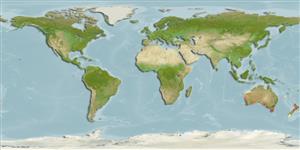Actinopterygii (ray-finned fishes) >
Gobiesociformes (Clingfishes) >
Gobiesocidae (Clingfishes and singleslits) > Gobiesocinae
Etymology: Parvicrepis: Latin, parvus = small + Latin, crepare = crackling noise (Ref. 45335).
Environment / Climate / Range
Ecology
Marine; reef-associated. Subtropical, preferred ?
Indo-Pacific: south-west coast to north of Sydney, Australia.
Size / Weight / Age
Maturity: Lm ? range ? - ? cm
Max length : 3.0 cm TL male/unsexed; (Ref. 9002)
Short description
Morphology | Morphometrics
Dorsal
spines
(total): 0;
Dorsal
soft rays
(total): 3-5;
Anal
spines: 0;
Anal
soft rays: 4 - 6. Caudal fin rounded (Ref. 9002). Pelvic fins united into double-sucking-disc, posterior half with fleshy lobes (Ref. 9002). Various shades of green, from yellowish or brownish to dark green, usually with some darker spotting (Ref. 9002).
Occurs in shallow weed and seagrass reefs, mostly intertidal (Ref. 9002).
Life cycle and mating behavior
Maturity | Reproduction | Spawning | Eggs | Fecundity | Larvae
Kuiter, R.H., 1993. Coastal fishes of south-eastern Australia. University of Hawaii Press. Honolulu, Hawaii. 437 p. (Ref. 9002)
IUCN Red List Status (Ref. 115185)
CITES (Ref. 94142)
Not Evaluated
Threat to humans
Harmless
Human uses
More information
Common namesSynonymsMetabolismPredatorsEcotoxicologyReproductionMaturitySpawningFecundityEggsEgg development
Age/SizeGrowthLength-weightLength-lengthLength-frequenciesMorphometricsMorphologyLarvaeLarval dynamicsRecruitmentAbundance
ReferencesAquacultureAquaculture profileStrainsGeneticsAllele frequenciesHeritabilityDiseasesProcessingMass conversion
Tools
Special reports
Download XML
Internet sources
